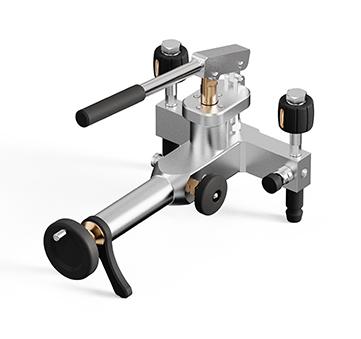The Usage Method of Portable Pressure Calibrator
Portable pressure calibrator is a tool which used for calibrating and testing pressure device, widely used in various industrial and laboratory environments. When using this device, a series of steps need to be followed to ensure accuracy and safety. The following is the basic usage method of a portable pressure calibrator:
1. Preparation Work
-* * Read the instruction manual * *: Before using the portable pressure calibrator, be sure to carefully read the operation manual to understand the device's functions, operating steps, and safety warnings.
-* * Check the equipment* *: Check whether the calibrator and all accessories are intact and undamaged, ensuring that there is no visible damage or abnormality.
-* * Choose appropriate connectors * *: Select appropriate connectors and pipelines based on the interface type of the device being tested.
2. Connect Devices
-* * Turn off pressure source * *: Before connecting the tested device, ensure that all pressure sources are turned off to prevent accidents.
-* * Connect the tested device * *: Connect the portable pressure calibrator to the tested device through appropriate connectors and pipelines. Ensure tight connections and no leaks.
3. Set Parameters
-* * Set pressure unit * *: Select the appropriate pressure unit as needed (such as Pa, psi, bar, etc.).
-* * Enter other necessary parameters * *: Depending on the specific model and function of the calibrator, other parameters may need to be entered, such as temperature compensation values, correction coefficients, etc.
4. Verify Pressure
-* *Gradually increase pressure* *: Turn on the pressure source and gradually increase the pressure to the desired calibration point. At each checkpoint, let the pressure stabilize for a few seconds.
-* *Record Reading* *: Record the pressure readings of the portable pressure calibrator and the device being verified, and compare the differences between the two.
-* * Repeat verification * *: Repeat the above steps at different pressure points to ensure the comprehensiveness and accuracy of the verification.
5. Release Pressure
-* * Slowly release pressure * *: After completing all calibration points, slowly turn off the pressure source and slowly release the pressure in the system to avoid damage caused by sudden pressure drops.
6. Disconnect the Connection
-* *Confirm complete release of pressure* *: Ensure that the pressure in the system has been completely released.
-* *Disconnect the device* *: Disconnect the portable pressure calibrator from the device being tested. Check all connections and pipelines to ensure they are not damaged.
7. Management and maintenance
-* * Clean the device * *: After use, clean the calibrator and all accessories.
-* * Regular Calibration * *: To ensure measurement accuracy, portable pressure calibrators should be regularly sent to professional institutions for calibration.
When using a portable pressure calibrator, safety is the primary consideration. Following the correct operating procedures and manufacturer's guidance is the foundation for ensuring safety and accuracy. If any problems are encountered during use, the operation should be stopped immediately and professional advice should be sought.
1. Preparation Work
-* * Read the instruction manual * *: Before using the portable pressure calibrator, be sure to carefully read the operation manual to understand the device's functions, operating steps, and safety warnings.
-* * Check the equipment* *: Check whether the calibrator and all accessories are intact and undamaged, ensuring that there is no visible damage or abnormality.
-* * Choose appropriate connectors * *: Select appropriate connectors and pipelines based on the interface type of the device being tested.
2. Connect Devices
-* * Turn off pressure source * *: Before connecting the tested device, ensure that all pressure sources are turned off to prevent accidents.
-* * Connect the tested device * *: Connect the portable pressure calibrator to the tested device through appropriate connectors and pipelines. Ensure tight connections and no leaks.
3. Set Parameters
-* * Set pressure unit * *: Select the appropriate pressure unit as needed (such as Pa, psi, bar, etc.).
-* * Enter other necessary parameters * *: Depending on the specific model and function of the calibrator, other parameters may need to be entered, such as temperature compensation values, correction coefficients, etc.
4. Verify Pressure
-* *Gradually increase pressure* *: Turn on the pressure source and gradually increase the pressure to the desired calibration point. At each checkpoint, let the pressure stabilize for a few seconds.
-* *Record Reading* *: Record the pressure readings of the portable pressure calibrator and the device being verified, and compare the differences between the two.
-* * Repeat verification * *: Repeat the above steps at different pressure points to ensure the comprehensiveness and accuracy of the verification.
5. Release Pressure
-* * Slowly release pressure * *: After completing all calibration points, slowly turn off the pressure source and slowly release the pressure in the system to avoid damage caused by sudden pressure drops.
6. Disconnect the Connection
-* *Confirm complete release of pressure* *: Ensure that the pressure in the system has been completely released.
-* *Disconnect the device* *: Disconnect the portable pressure calibrator from the device being tested. Check all connections and pipelines to ensure they are not damaged.
7. Management and maintenance
-* * Clean the device * *: After use, clean the calibrator and all accessories.
-* * Regular Calibration * *: To ensure measurement accuracy, portable pressure calibrators should be regularly sent to professional institutions for calibration.
When using a portable pressure calibrator, safety is the primary consideration. Following the correct operating procedures and manufacturer's guidance is the foundation for ensuring safety and accuracy. If any problems are encountered during use, the operation should be stopped immediately and professional advice should be sought.
